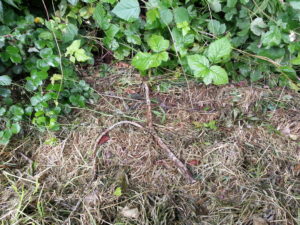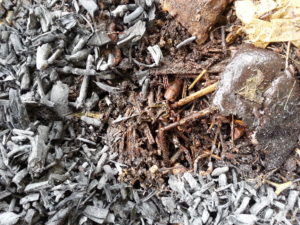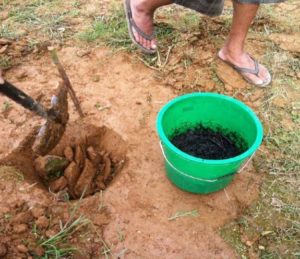What are the heroic actions that can save the planet from climate chaos? Solar panels? Electric cars? COP climate talks? All these heroes have been celebrated for decades – whilst the damage from climate instability continues to worsen mercilessly. We urgently need a new hero with new superpowers to save the day. With carbon villains out of control there’s not a moment to lose. Let’s now reveal the identity of this hero – and their inconspicuous disguise that causes them to be overlooked.
The humble Clark Kent of the fight against climate change, the disguise of our hero, is the dry stick. Dry sticks are barely noticeable as you walk down the road, past a hedgerow or through an orchard. For most people who do notice them, just one thought comes to mind, “Burn it!”. Mountains of sticks are burnt every day in bonfires, incinerators, fireplaces and cookstoves, while the forests supplying them steadily shrink away.
Few people realise that the dry stick is a disguise. When called into action any dry stick can quickly transform into an awesome planet-saving hero. But when touched, our hero makes your hands dirty so it can be hard to see it as a hero. When most people see it, their minds are overcome with that same single thought, “Burn it!”. Yet if we can restrain ourselves from setting fire to our hero then we can discover its superpowers. When called into action for the climate, dry sticks become charcoal that’s called biochar.
Our hero, biochar, has four spectacular superpowers.
Superpower 1. Cooking Rescue
When you’re drinking beer around the campfire and smoke gets in your eyes it’s a nuisance. For 4.3 million people in developing countries, smoke from cooking is a death sentence. The international development community has responded  inadequately, believing the challenge is to burn wood or charcoal more efficiently or to switch to ‘modern’ fuels which repeat the fatal error of fossil fuel dependence in industrialized countries. There is now increasing interest in cooking that harnesses the huge release of energy when dry sticks are transformed into biochar. Rather than burning dry sticks or charcoal to produce ash, cooking can cleanly efficiently produce charcoal.
inadequately, believing the challenge is to burn wood or charcoal more efficiently or to switch to ‘modern’ fuels which repeat the fatal error of fossil fuel dependence in industrialized countries. There is now increasing interest in cooking that harnesses the huge release of energy when dry sticks are transformed into biochar. Rather than burning dry sticks or charcoal to produce ash, cooking can cleanly efficiently produce charcoal.
Superpower 2. Soil Rescue
It is no coincidence that poor communities worldwide rely upon poor soils to grow their food. Mainstream international development has been unable to help due to blind faith in the Western agricultural model of monocultures cultivated in soil that most closely resembles a sterile desert. Intensive industrial agriculture is so ineffective in developing countries that the outcome according to WHO estimates is 3 million farmers attempting suicide with pesticides every year.
Adding biochar to compost and then to soil offers food security with a new understanding of soil. Then the soil is not there just to hold plants upright; it’s an ecology where biochar is the host for symbiotic mycorrhizal fungi that stores and transports water and nutrients to plant roots, with little or no need for synthetic fertilisers and pesticides.
Superpower 3. Forest Rescue
The world loses around 20 million hectares of tree cover every year. The efforts of international organisations to ‘manage’ this loss by aiming to reduce it fail to understand the basis of sustainability. We must aim not to destroy forests more slowly but to everywhere stop destroying them and instead regenerate them.
There is a proliferation of ‘improved cookstove’ initiatives to burn trees or to burn charcoal more efficiently. The end-point of this ‘improvement’ would be to turn every available tree to ash and atmospheric carbon. Cookstoves that produce biochar enable a regenerative system. Prunings from protected trees (or agricultural byproducts) become fuel. The biochar left-over from cooking is returned to the soil, building the underground ecosystem to support resilient new forest cover.
Superpower 4. Climate Rescue
Imagining life without a stable climate is really hard to do. Many people find it easier to instead imagine there is no climate problem. Almost everyone else finds it easier to instead imagine that humanity is on a path toward ensuring a future stable climate. The outcome of these two easy options is that the imaginative leap needed to really care for the climate has not been made. Biochar is largely non-biodegradeable over centuries or millennia. It shows us that carbon can be removed from the atmosphere at little or no cost. It shows us that the convenient goal of cutting carbon emissions can be upgraded to the necessary goal of cutting carbon concentrations. Our hero is available worldwide so people everywhere can call biochar into action and make climate rescue possible.
Read about 2050Kids Biochar Cookstove Project.




Really interesting! It seems the answer is right in front of us, and it simply lies in replacing the habit of burning dry wood for ‘biochar-ing’ it. One question, are there any issues with the fact that biochar is largely non-biodegradable? For example, are there potential risks from biochar build up in the soils?
Great comment thanks Lucy. Yes, it’s that simple! The fun thing is that by charring you get 3/4 of the energy available in the wood and the heat is focussed in one place so it works out much more efficient than just burning wood. Allowing the biochar to build up is exactly the plan – here’s a pic of ancient biochar use that created 1m deep topsoil. https://en.wikipedia.org/wiki/Terra_preta